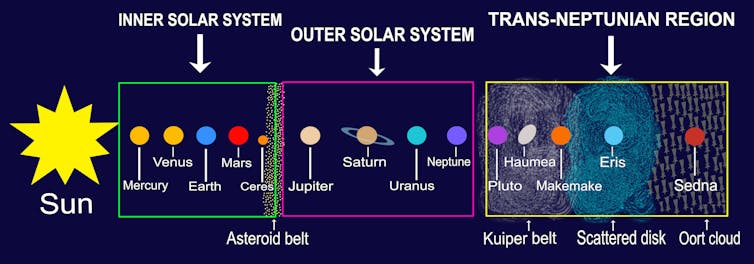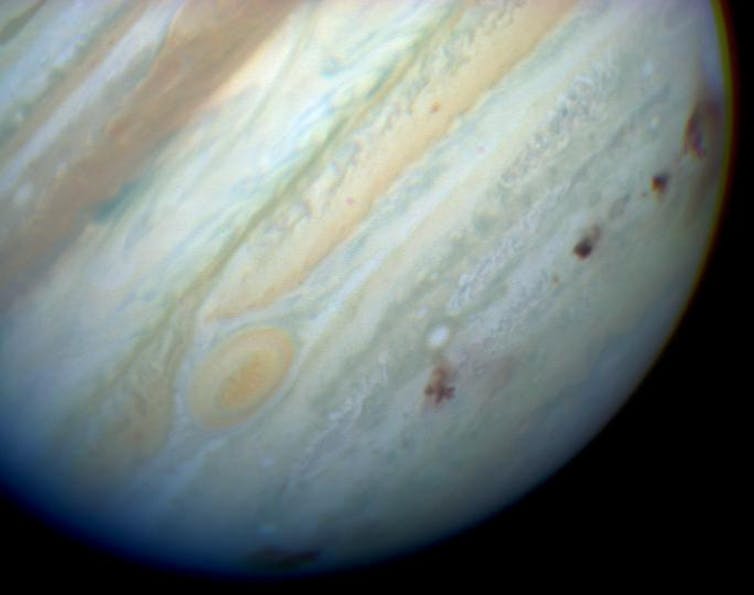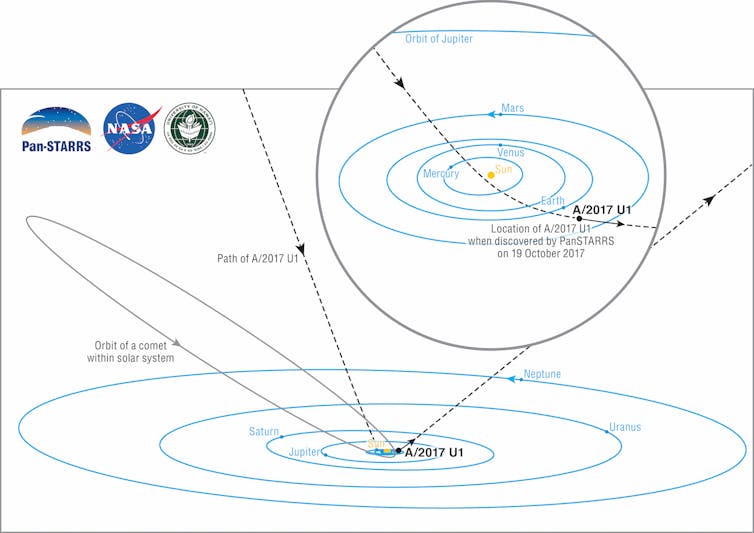A fleeting visit: an asteroid from another planetary system just shot past Earth
- Written by Jonti Horner, Vice Chancellor's Senior Research Fellow, University of Southern Queensland
The discovery of an unusual small object in the Solar system last month caught the imagination of the global astronomical community. Scientists around the world were asking “what is it?” and “where did it come from?”
Within days, they realised this tiny body was moving very quickly, and might not be bound to our Solar System. Astronomers swung telescopes towards the faint object, and soon confirmed it as the first interstellar object ever observed passing through the Solar system.
So will there be more of these celestial vagabonds? To answer that question, we must first take a close look at our own Solar system.
Read more: Water, water, everywhere in our Solar system but what does that mean for life?
Comets and asteroids - leftovers of creation
The Solar system includes debris left behind from its formation. The bulk of that material is trapped in regions where objects remain relatively unperturbed on timescales of billions of years.
Between the orbits of Mars and Jupiter lurk millions of asteroids, the relics of planet formation. Beyond the orbit of Neptune are the trans-Neptunian objects - millions of icy bodies, held in cold storage. Finally, stretching halfway to the nearest star, is the Oort cloud, thought to contain more than ten trillion cometary nuclei.
 The regions of our Solar system (not to scale).
Shutterstock/hydra viridis
The regions of our Solar system (not to scale).
Shutterstock/hydra viridis
Most of these objects will remain in these regions forevermore. But over time a small fraction will be shaken loose, injected to orbits that are far less stable.
They then live brief, chaotic lives. Flung around the Solar system as a result of the gravitational influence of the planets, they can end up on orbits that bring them close to Earth and the Sun.
Some will fall apart, while others will crash into one of the planets. The majority will eventually leave the Solar system, never to return. Such ejections are far from a new phenomenon as the Solar system has been shedding debris since it formed.
 In 1994, fragments of comet Shoemaker-Levy 9 collided with Jupiter, leaving scars the size of the Earth.
Hubble Space Telescope Comet Team and NASA
In 1994, fragments of comet Shoemaker-Levy 9 collided with Jupiter, leaving scars the size of the Earth.
Hubble Space Telescope Comet Team and NASA
The Solar system in not unique
Over the past 20 years, we have learned that the majority of stars are accompanied by planets and their attendant debris. Observing stars at infrared wavelengths, we have learned that many are also accompanied by far greater quantities of debris than we see in the Solar system.
We therefore move in a galaxy full of stars that are shedding debris to the depths of space. The void between the stars is far from empty.
With so much material floating freely in space, it was always likely that some of that debris would swing close enough to the Sun for us to detect it – which brings us back to our newly discovered object.
Our first interstellar vagabond
When the new object was first detected, it was apparent that it was moving on a highly elongated orbit. For that reason, scientists assumed it was a long-period comet, and named it C/2017 U1 Pan-STARRS.
As more observations were made, the only way that scientists could fit the object’s orbit to the data was if it was moving on a hyperbolic orbit – in other words, if it was not gravitationally bound to the Solar system.
Animation showing the orbit of the interstellar asteroid A/2017 U1.Over the days that followed the object’s discovery, detailed observations revealed no evidence of any cometary activity. Long exposures using the world’s largest telescopes showed nothing more than a fast moving speck of light.
Rather than a comet, the object seems asteroidal, which suggests it formed relatively close to its parent star. As a result, it was renamed A/2017 U1 – the first time in history that an object has been reclassified as being solely an asteroid rather than a comet.
But where did it come from?
Now we have a better handle on how A/2017 U1 is moving, people have begun to speculate on its origin.
Tracking its orbit back in time is no easy task. The further back we look, the less precisely we can say exactly where the object was.
What we can say is that A/2017 U1 approached the Solar system from roughly the direction of the bright northern star Vega. We know the inbound direction to about one-fifth of a degree, and the path lies around five degrees from that star in the northern sky.
Unfortunately, we can’t go from this to tying A/2017 U1’s origin to any given star. To do that we would need to know the motions of every single star with exquisite precision, as well as how they affect one another (and our object).
But what we can say is that the asteroid originates from a star within our own galaxy. Were it an intergalactic guest, it would be travelling much faster.
 The path of A/2017 U1 (dashed line) as it crossed the plane of the planets in our Solar system and then turned and headed back out.
Brooks Bays/SOEST Publication Services/UH Institute for Astronomy
The path of A/2017 U1 (dashed line) as it crossed the plane of the planets in our Solar system and then turned and headed back out.
Brooks Bays/SOEST Publication Services/UH Institute for Astronomy
The future
What do we learn from A/2017 U1’s fleeting visit? The most important result is the confirmation of a long held expectation – that we would eventually discover comets and asteroids from distant stars sleeting through our Solar system.
Read more: Say hello to the Earth’s nearest exoplanet neighbour: Proxima Centauri b
In coming years, new surveys will vastly increase our chances of finding further visitors. Eventually, such discoveries will be commonplace, and we will learn how many objects like A/2017 U1 are scattered through the galaxy. This will provide a wealth of information on how planetary systems form and evolve.
If we detect such objects with enough warning, more detailed observations could examine their chemical and isotopic compositions, allowing us to sample the makeup of planetary systems far from our own. The possibilities are endless, and hugely exciting!
But what of A/2017 U1’s fate? Its days near the Sun are over, and it is rapidly heading back to the cold depths of interstellar space.
In millions or billions of years, it might swing past another star, and visit alien worlds - but most likely it will continue to drift forevermore, cold and dark, through the spaces between the stars.
Authors: Jonti Horner, Vice Chancellor's Senior Research Fellow, University of Southern Queensland




